Back in 2018 and 2019, the annual Consumer Electronics Show (CES) reached peak sports tech goodness. There was nearly an entire hall full of sports tech companies big and small – many with elaborate booths and even scheduled fitness-focused dance performances every 30 minutes. By CES in early January 2020, that had started to fade quite a bit, and then of course CES 2021/2022 were impacted by COVID. This year for CES 2023, it was even more muted, with virtually no sports tech-related announcements. The most notable health/fitness announcement was a toilet bowl urine analyzer. And, while certainly interesting in its own unique way – this was no 2018.
But buried at the end of a press release from Qualcomm and Iridium last week was a single quote from the head of Garmin’s Outdoor division (overseeing Fenix/Epix/Instinct/inReach/handhelds/etc), talking about a barely mentioned new partnership designed to go head-to-head with Apple’s Emergency SOS via Satellite search that was launched back in November (and December in Europe).
“Garmin welcomes the opportunity to expand our proven satellite emergency response services to millions of new smartphone users globally,” said Brad Trenkle, vice president of Garmin’s outdoor segment. “Garmin Response supports thousands of SOS incidents each year and has likely saved many lives in the process, and we are looking forward to collaborating with Qualcomm Technologies and Iridium to help people connect to emergency services no matter where life takes them.”
Now from a technical standpoint, the announcement from Qualcomm is grander in plans than what Apple has implemented to date. It’s not limited to just emergency services, nor just a handful of countries. So let’s dive into how Garmin specifically is involved, and whether or not they might leverage the chipset in the near term, all of which is pretty fascinating.
Snapdragon Satellite & Emergency Response:
To back up a bit, Qualcomm announced their Snapdragon Satellite, which is atop their Snapdragon 8 Gen2 mobile platform. This chipset is primarily used by phone and tablet makers, as well as other larger form factor devices as a do-it-all component. It does everything from WiFi to cellular, graphics handling, and CPU. It’s the core of a smartphone. However, the key new feature is Snapdragon Satellite, which would allow phones direct communication with satellites. This would ride atop Iridium’s low-earth-orbit (LEO) satellites, which are currently used by a number of companies including Garmin’s inReach devices.
Qualcomm specifically noted that this chipset will be “used by Emergency messaging on Snapdragon Satellite…planned to be available on next-generation smartphones, launched in select regions starting in the second half of 2023”. Meaning, they’ve already signed up some manufacturers with this chipset, and those manufacturers are already likely testing these chipsets in early pre-production form. Additionally, Qualcomm noted that it’s more than just emergency features, saying:
“Qualcomm and Iridium entered into an agreement to bring satellite-based connectivity to next-generation premium Android smartphones. Garmin looks forward to collaborating with support for emergency messaging.
Snapdragon Satellite offers truly global coverage from pole to pole and can support two-way messaging for emergency use, SMS texting, and other messaging applications – for a variety of purposes such as emergencies or recreation in remote, rural and offshore locations.”
There’s a fair bit of notable stuff in that press release opener quote. First, this chipset/satellite combo will have enough bandwidth for premium communications, things like regular text messaging. You’re not streaming YouTube over this yet, but rather just simple text. Still, that’s more than Apple allows today, which is a highly compressed emergency-only text function (and also highly-compressed FindMy updates). However, like Apple, Qualcomm is announcing emergency functions first, and specifically, emergency response functions via Garmin.
Today, Garmin inReach satellite communicator (and other inReach embedded devices) communicate to Garmin’s IERCC (International Emergency Response Coordination Center), which Garmin is slowly shifting towards just calling it “Garmin Response”. Basically, when you fall off the side of a cliff in the middle of Alaska or Zimbabwe without cell coverage, it contacts via satellite to the emergency response center, which coordinates with various local entities to save your bacon. Garmin recently announced their 10,000th ‘save’ via this service (and 105,000 SOS calls overall).
(If you want to see what happens when you press that SOS button in the real world, here’s a post and video I did showing it.)
In this model, Garmin’s emergency response center is roughly akin to what Apple has developed with Globalstar (a satellite provider that also now has an emergency response center), except that Garmin handles it no matter where on earth you are, whereas Apple is just a handful of countries today. Inversely, Apple only requires an iPhone 14 series device, whereas Garmin requires an inReach device (or Forerunner 945 LTE). Both require subscriptions, though Apple has waived the fee for the first two years.
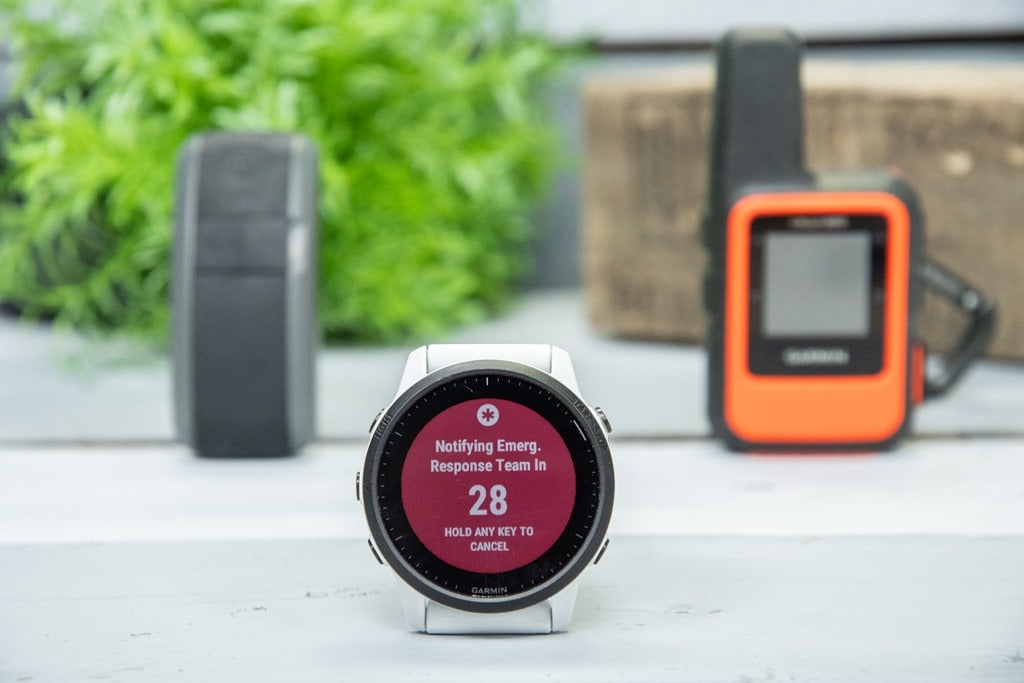
However, the point of all that backstory is that today the primary route into the Garmin Emergency Response system/center is via a Garmin device (Update: Looks like a handful of small apps/companies also leverage it too). But this Qualcomm partnership aims to change that in a big way. Going forward, Qualcomm customers using this chipset will essentially have a plug & play option to utilize Garmin’s Response center.
This means that later this year when whomever that phone manufacturer is that is using this chipset could have customers tap directly into the Garmin Response center, just like Apple iPhone users connect to Apple’s emergency response centers. The idea being that a company like Samsung, Oppo, Xiaomi, and others have effectively an easy-button to offering competing satellite emergency services.
While nobody is going to discuss future subscription pricing, undoubtedly with Apple offering a free 2-year trial, realistically anyone else is going to have to match that – especially for flagship phones. Qualcomm chipsets are heavily used across Android phones/tablets (albeit with Google Pixel switching to Tensor this past year). Obviously, this isn’t targeted at Apple, given Apple is spending half a billion dollars (Billion with a B, like buffalo) to launch their competing service.
Finally, it’s worth noting that T-Mobile and SpaceX announced a partnership as well, back in August. However, there is very little concrete information about the effort, and in a best-case scenario it might be beta testing by the end of 2023 (limited to the United States). The first batch of 54 Gen2 satellites finally just launched 10 days ago (out of a planned 7,500 satellites). Still, no matter how one feels about Elon Musk’s ventures, even his most ardent supporters would agree that while he usually eventually completes what he promises, things are rarely on time (or anywhere near it). The August announcement was made days before Apple’s fall satellite announcement, mostly as a PR/marketing preempt. Still, fast forward to 2024 or 2025, and what SpaceX is outlining could be incredibly fascinating.
Satellites in Garmin Bike Computers or Watches?
This of course then immediately begs the question, will we start to see these Qualcomm chipsets in other Garmin devices instead of the larger inReach antennas? And would that mean smaller devices like a bike computer or GPS watch might soon have direct-to-satellite connectivity?
Well, it’s complicated.
To begin, I asked Garmin whether or not this chipset would sidestep the need for the larger/bulky satellite antenna found on an inReach device today. The answer there is “with tradeoffs, yes”, meaning that when you have this chipset it has a corresponding smaller antenna that’s designed for a smartphone form factor. This means there are tradeoffs in things like how reliable the transmission is, or how a user would use it.
For example, with Apple’s iPhone 14 solution, the user has to basically point the phone towards a specific location (satellite) in the sky. Qualcomm also has a relatively similar demo showing the same thing. And specifically, you stop and do this when you want to communicate via satellite. Whereas with a Garmin inReach device and its omnidirectional antenna, the communications just happen 24×7 in the background, because the antenna can always find satellites. But again, there’s the tradeoff in antenna size (you can see the antenna at the top of the orange inReach device, two photos below). Here’s the user prompts while using Apple’s satellite service:
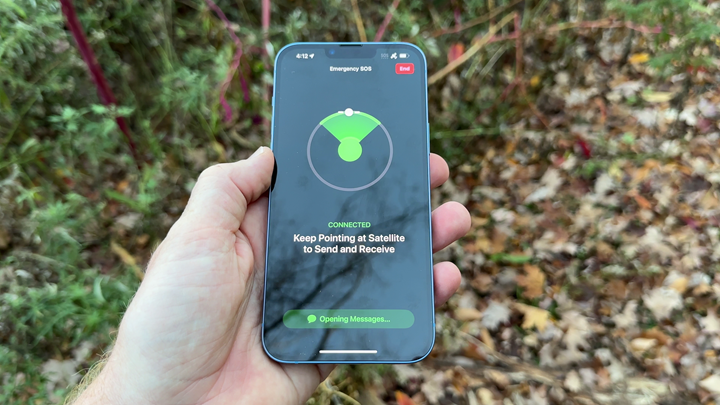
In other words, Garmin sees this as an alternative technology solution for different platforms/use cases – but one that still ultimately lands at Garmin’s emergency response center doorstep to handle/process. For the average consumer smartphone, you can’t have a giant inReach-style antenna sticking out the top, whereas, you can have a seamless and invisible antenna that can be leveraged on-demand for emergency or other short messages.
Looking at Garmin’s current inReach product lineup, the Snapdragon Satellite chipset doesn’t really work for most of these devices. First, it’s got too high a power draw to be on 24×7 in a handheld device. Remember, Snapdragon Satellite as a feature is largely designed to be event-focused (e.g. sending a single message), whereas inReach is typically designed to be constantly communicating at intervals in the background. Second, Garmin says the solution doesn’t meet the component cost requirements for Garmin’s lower-priced inReach devices (e.g. $299 for an inReach device, as compared to a $1,000+ smartphone). However, Garmin again notes that for smartphones with larger batteries or higher price points, Qualcomm’s solution is appealing.
For cyclists and others, that immediately begs the question of whether or not Snapdragon Satellite can be leveraged in something like a bike computer?
Obviously, never say never, but for now, speaking generally, the answer is no. Specifically, Garmin noted two challenges: The first is simply that the components cost is cost prohibitive (today) for a bike computer format. Meaning that like the $299 inReach device cost component challenge, the same is true for Garmin’s bike computers costing $299-$749. In the same way that solar components are still very expensive for Garmin (despite owning the technology), and why they’ve largely been reserved for higher-priced devices to date. Obviously, as with any component, they get cheaper over time, and can be counter-balanced with other cheaper build costs (see: Garmin Instinct Solar series).
The second challenge Garmin says for bike computers is that “fixed-mount” nature can be challenging from a connectivity standpoint. Again, remember that with Snapdragon Satellite, in a phone, the solution requires you point your phone at the specific satellite passing by. Certainly, you can remove the bike computer from the bike and do this, but there are some user experience components there that this wouldn’t be when just riding along, but really more of an emergency solution (hence why power draw actually wasn’t Garmin’s concern in a bike-computer format, since it’d basically have to be manual/on-demand only).
So if you were hoping to find Snapdragon Satellite in a bike computer coming to you soon, that seems pretty darn unlikely. Garmin however currently has direct integration already with their inReach devices to their Edge bike computers (and most higher-end Garmin watches). That allows you to send/receive messages on the Edge display, with a connected inReach device. Of course, while that’s a good first step, I think a lot of us would also love to see seamless hand-off between cellular and inReach Live Tracking (for example), which isn’t done today. Nor is there any emergency notification of crashes via inReach satellite devices today. All are largely software-focused areas that Garmin could implement internally.
Going forward:
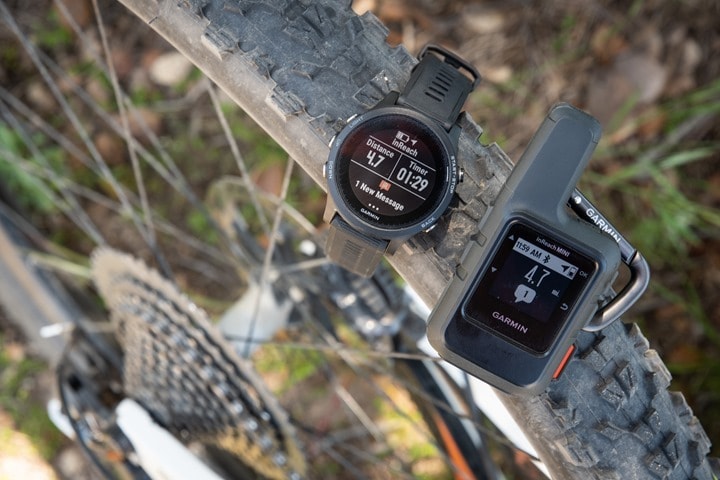
Undoubtedly, more accessible low earth orbit satellite connectivity will be “5G” style topic over the next few years. We’ve finally gotten past everyone putting 5G in every marketing thing they can, but I suspect satellite connectivity will become that replacement frontier. And perhaps for good measure. While faster internet is always interesting, having more accessibility to the internet in far-flung places is arguably just as useful (if not more useful). Even if that connectivity is low-speed.
As I said when Apple launched their satellite SOS system on the iPhone 14, if we fast forward 3-5 years from now, virtually everyone that has an iPhone will have emergency response center access. We’re already seeing it save lives in just the last two months, and for people like my father-in-law who lives in very remote Canada and travels deep off the grid, this type of technology becomes instantly accessible via just an inevitable and eventual new phone purchase.
What Qualcomm is doing with Garmin for Snapdragon Satellite is applying that same long-term vision for the rest of the world on Android. And long term, if we think about the investment that Apple has made with Globalstar (hundreds of millions of dollars to support initial rollout), that sort of same cash flow will be flowing towards Garmin and Iridium (and a lesser extent Qualcomm). Long term, this could become a massive source of revenue. So when people talk about Apple SOS (or likewise) killing Garmin inReach, I suspect Garmin is just sitting back knowing that they’re still gonna end up with plenty of Android-driven response revenue either way. And that all ignores the simple reality that today inReach devices fulfill a different need than smartphone satellite connectivity.
And hey, maybe down the road they’ll figure out how to bake Snapdragon Satellite or similar satellite componentry and antennas into bike computers (or perhaps bike lights/radar, or bike-specific accessory) such that it can work in an always-on tracking config without having to hold your phone/device like a token to the satellite gods.
With that, thanks for reading!
FOUND THIS POST USEFUL? SUPPORT THE SITE!
Hopefully, you found this post useful. The website is really a labor of love, so please consider becoming a DC RAINMAKER Supporter. This gets you an ad-free experience, and access to our (mostly) bi-monthly behind-the-scenes video series of “Shed Talkin’”.
Support DCRainMaker - Shop on Amazon
Otherwise, perhaps consider using the below link if shopping on Amazon. As an Amazon Associate, I earn from qualifying purchases. It doesn’t cost you anything extra, but your purchases help support this website a lot. It could simply be buying toilet paper, or this pizza oven we use and love.

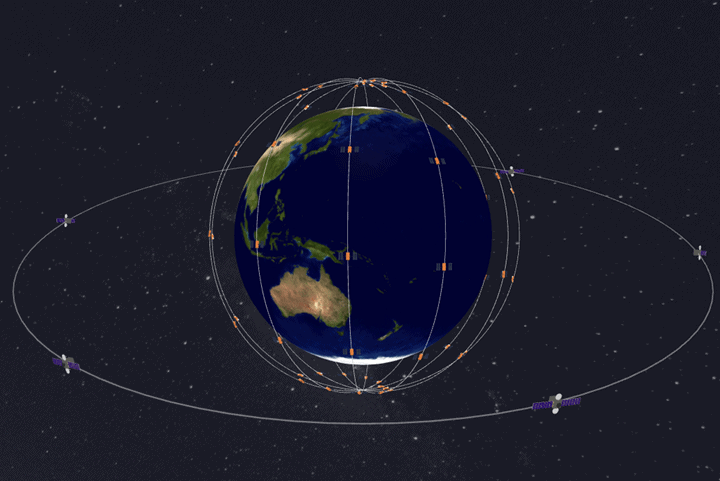
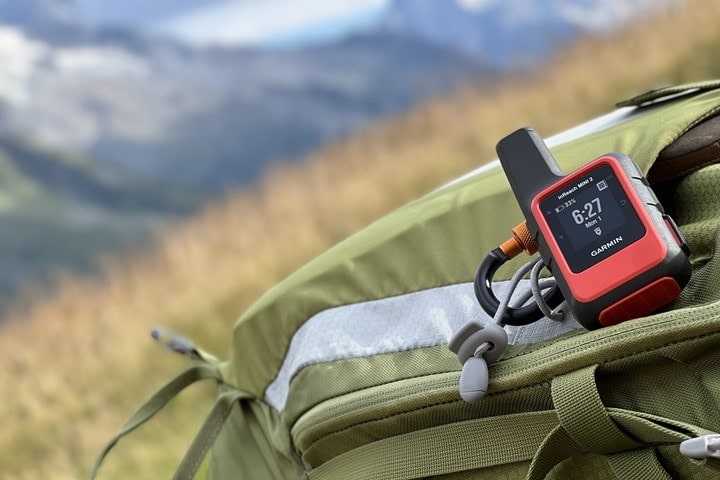
![clip_image001[6] clip_image001[6]](https://media.dcrainmaker.com/images/2023/01/clip_image0016_thumb.jpg)
![clip_image001[8] clip_image001[8]](https://media.dcrainmaker.com/images/2023/01/clip_image0018_thumb.jpg)
















Interesting. I hope not that Garmin is thinking about to exhume the nüvifone…
If it will get a feature for the masses, I fear there will be a lot of false alerts triggered by dumbos and people with the real emergencies will get into trouble (or Garmin has to massively upgrade the response center in terms of personnel and technology).
I don’t think there’s any plans of a Nuviphone. Like action cams, that ship has long ago sailed.
“The token to the Satellite Gods”… hilarious 😂😂😂, thanks Ray
“ whereas Garmin requires an inReach device (or Forerunner 945 LTE)”
You can trigger a SOS via Iridium network with a fr945 lte?
Not via Iridium, but via LTE, yes. I think that’s the only cellular entryway to the IERCC platform. I could see how the sentence might be a big confusing, will tweak
Garmin should partnered with Starlink for connectivity. Instead of just sos messages you could do text, love tracking, even music
The thing is, Garmin has been using Iridium for many many many years (previously as Delorme). Starlink’s Gen2 system isn’t live yet.
And remember, this is really about Qualcomm partnering with Iridium, and using Garmin as the platform of choice for emergency response. While Garmin could certainly use the Snapdragon chipset if they had a use for it (perhaps in some of their bigger devices or such, though those usually have antenna space anyway), Garmin already has a solution in place today that’s live and in use, and available “pole to pole”, which I don’t think Starlink advertises today (but is key for emergency operations).
Point being, ultimately, Garmin is a free agent here. And could certainly shift to other technologies as they make sense.
But it seems that Garmin is 👀 forward to it:
“Garmin welcomes the opportunity to expand our proven satellite emergency response services to millions of new smartphone users globally,” said Brad Trenkle, vice president of Garmin’s outdoor segment. “Garmin Response supports thousands of SOS incidents each year and has likely saved many lives in the process, and we are looking forward to collaborating with Qualcomm Technologies and Iridium to help people connect to emergency services no matter where life takes them.”
I think in case of an emergency, you will get an announcement: please hold the line, 225 callers are in front of you. Your waiting time is 3hrs and 57 minute. Please stay alive and thank you for using the Garmin response center. If you don’t want to wait, please call later again…😇
The one advantage Garmin has is that they undoubtedly already have industry scuttlebutt numbers from people working at Globalstar/Apple on what the demand ratio looks like for cellular users. Apple themselves advertised exactly how many people are in those centers at launch, and the satellite response realm is a pretty small world. The staffing level numbers and call numbers undoubtedly are already known by Garmin/etc, and they have a year to expand call centers as needed.
This will require a separate paid subscription, which solve the spam/prank problem? If you misuse the service, you get banned from acquiring a subscription? They could also fine you?
Yeah, I wonder how much the false-call issue is real today for Apple. I suspect there are undoubtedly people each time Apple lights up the service in a country that “test” it out, and then basically (hopefully) say “oops” before “hanging up”. But, as annoying as that is for Apple, I also suspect demand-wise on their platform it’s effectively trivial.
Obviously, if Apple’s Relay centers hand it off to SAR, and someone goes out for a fake call, then I’m 100% in team “fine the crap out of them” (or, whatever other legal possibilities are there).
Sorry, me again🤓 Ray, did you forget the Garmin inReach Messenger?
“ Whereas with a Garmin inReach device and its omnidirectional antenna, the communications just happen 24×7 in the background, because the antenna can always find satellites. But again, there’s the tradeoff in antenna size…”
Nope, didn’t forget :). While inReach Messenger doesn’t have the omnidirectional antenna, I was basically referring to it with the “antenna size” bit, as the antenna size is still massive – but just flatish in comparison.
And even with that flat-patch antenna design, as long as the thing isn’t like a turtle upside, it’s effectively omnidirecitional to the sky (such as on a car dashboard or at a campsite), as the entire upper surface can see all directions. Whereas with the phone solutions, generally, the top edge is the desired thing to point at the satellites (though, like inReach messenger, you can get away with a fair bit of deviation – as I showed in my iPhone 14 SOS tests).
Ah, ok. It sounded to me like all Garmin inReach devices have the omnidirectional antenna. It’s probably due to my English…
I know that the messenger has no omnidirectional Antenne (own one).😉
Competition is good, even if Iridium has a less than stellar (sorry for the pun!) track record.
The thing I really like the least with an Garmin InReach Remote setup:
Neither watches nor Edges trigger the SOS via satellite when the recognize a crash. To get help via satellite you always have to trigger either the SOS button on the InReach or open the remote widget/app and do it there.
Totally agree. At this point, I feel like that should at a minimum be on the ‘this spring’ feature roadmap. While I see the value in uncovering the SOS button on inReach, the reality is the SOS emergency trigger (including crashes) to the IERCC is already there today on the FR945 LTE.
But ultimately, what I really want (and honestly value more for day to day usage on big trips), is simply that LiveTrack fails over to inReach automatically when cellular service gaps out. Given I’m already tracking via inReach, there’s no added communications. And especially because of all the things that inReach does well, LiveTrack for longer multi-day trips is 100% not one of them. There’s all sorts of wonk there, and ultimately it falls short of Garmin’s cellular based LiveTrack platform. I think it’s fair to find balance with things like HR/power/etc over satellite if that’s too big a demand, but basic location should failover.
I’ve owned the Garmin inReach since it first became available in 2018. I bike tour all over the world and have used my Garmin inReach on 2 occasions for SOS. In Sri Lanka, I had to ride a safari truck through a national park that did not allow cyclists through. The truck broked down 15Km in the park, and we were surrounded by elephants and tracks of leopards. I was with two Sri Lankans and after they could not get cell signal, I activated the SOS on my inReach; Garmin’s emergency services were contacted and the were able reach emergency services in area I was located, got a tuk tuk to come take me and the bike through the rest of park. I again had to activate the SOS in northern Cambodia when my rear wheel completely exploded, separated in half while bike on a rural road with no traffic. Again the emergency services got me out of a tough situation. The inReach has become my most important item I take on my bike tours (like riding across Europe this past summer from Paris to Romania). I’m amazed at the easy of being able to use it paired with my iPhone on Earthmate.
I’m quite interested in how Wahoo decides to compete in this arena.
That‘s a joke, isn‘t it?
Nice catch, Ray, and super interesting development.
In the ‘Satellites in Garmin Bike Computers or Watches?’ section, you get into detail on the (seemingly unlikely) possibilities of a bike computer application, but how about high end watches which have similar price points to premium smartphone segment to which Snapdragon Satellite is marketed? Would it leapfrog the Garmin’s current LTE offerings or only be relied on if cellular doesn’t work?
If combined with the messaging piece you recently covered on the Bounce, that would be very appealing functionality that would finally allow me to run with just a Fenix/Epix and have a form of backup emergency communication
There’s definitely discussion on making it work in a watch form factor, namely for SOS one-off emergency aspects (with the whole point and rotate thing like on the phone). People I’ve chatted with at a few companies say the antenna design is certainly viable, but everyone is a bit fuzzy on what those timelines look like.
I’ve gotta imagine though that if Garmin can find a way to make that work, that’d be an excellent Fenix ‘X’ launch feature. Or heck, an excellent ‘MARQ’ series feature if Garmin really wants to differentiate things.
Very interesting for were I live in Australia. Geographically most of Australia does not have any cell phone coverage. Even many areas that are covered by coverage maps have only marginal coverage at best. So additional satellite options are always interesting. In my own case I use a spot tracker. I know these are also very popular with people riding marathon events like Audax rides.
I see this chipset as a Zoleo competitor – the text via Satellite from cell phones service.
link to zoleo.com
For Garmin they probably already have covered the “sunk costs” of the IERCC with regular subscription income from InReach users. So it makes sense to offer Satellite Emergency Contact services to other companies.
I live in Central NY state, Finger Lakes region, cell phone service can be spotty to non-existent on the trails around here. So I carry an InReach with basic service with me all the time when I am out and about.
Until a few years ago when a cell tower went up just south of us, I got better service in our front field from our cordless house phone with a signal booster, than from my cell phone.
Btw: Zoleo (and some others) are using the Garmin IERCC response service:
link to iercc.com
Very interesting, especially that lower list of LTE apps.
Hey Ray, me again :)
How is that to be understood with the fr945lte and IERCC? I might buy an LTE contract. How much does it cost me to use the IERCC response service in an emergency? Where are the costs calculated? Is that included in the purchase price of the fr945lte? I don’t seem to understand something there!? Can you enlighten me?
Ok, did some research: you have to buy a Garmin lte Plan in Germany (7,99€ monthly plan or 6,99€ yearly plan, I am located in Germany) and get IERCC support. But as far as I read, it is only available in some countries not worldwide (like a regular iR plan) and if you have no lte reception, you can not send your SOS. So for a worldwide and permanent possibility to send an SOS, an iR device with subscription plan is needed. Correct?
So are they going to drop the fees to something a little more in line with the rest of the telecommunications industry? Irridium network was really cool 35 years ago but paying military contractor prices for weekend warrior peace of mind is a little nuts, even though I do it. Not saying we need unlimited TikTok, but how about just favorites filtered email?
Over time, sure, but for emergency stuff (or, as inReach does today with LiveTracking/etc), it’s pretty reasonable, starting at $14/month: link to garmin.com
Of course, I expect cell-based SOS-only to be far cheaper. For example in two years when Apple has to get around to deciding what the pricing is, my guess is that it’ll be $5/month or such, maybe $3-$4/month, or more likely – bundled with one of the Apple subscription bundles. Same concept goes for Android.
I wonder if there is another opportunity here, and use the very basic short message connectivity outside of emergencies. Opentracking is a company here in the UK that hires out cell-based trackers that are the source for ‘dot watching’ on many well known events like The Spine Race.
link to opentracking.co.uk
They are small, tape to the shoulder strap on your pack and give regular location updates as well as having an SoS function. I’ve used one on a few occasions and they’re about the size of an inReach and unnoticeable once taped on. Connectivity is actually done using an international SIM so they roam onto any of the UK networks and have the best shot at getting cell coverage in a given location. But in MANY remote races, coverage is just so patchy that they drop in and out. Satellite coverage would solve this, and the antenna wouldn’t be an issue.
I think Ray nailed it that the antennae is the real limiting factor on ever seeing these things in smaller packages. I suspect it just takes alot of power and alot of antennae to get a signal from the earth to outerspace. Not to mention all the interference with all the other signals from mankind bouncing around. I have begun using an old Delorme Inreach and a Spot tracker over the last year or so and find that both have significant issues in being 100% reliable in tracking and messages. Even a couple weeks ago in wide open Big Bend my Spot missed alot of tracking points. Luckily, I haven’t had the need for SOS on either but certainly concerned with how long it will take either one to get a signal. I can’t imagine the frustration with a lower powered smaller antennaed device.
I’m confused.
If Qualcomm and Iridium are partnering with Android (especially Pixel phones), how does this set Garmin up for success?
Seems like Pixel phones would then just be another competitor for Garmin, just like the iPhones (though again, likely more limited in services and connectivity).
Seems like Garmin’s niche is more robust emergency services, while iPhone and Android are more intended as a back-up for more casual potential users.
Because the service via Qualcomm/Iridium for emergency services, runs through Garmin. So no matter the device, Garmin gets the revenue.
Great article! I work at Garmin as Software Team Lead for consumer automotive. We developed off-road navigators with built-in inReach, including a Baja racing navigator that allows Baja teams to track progress during races using the inReach satellite link.